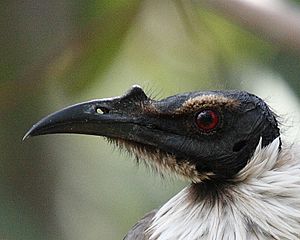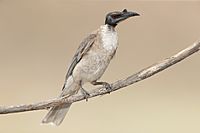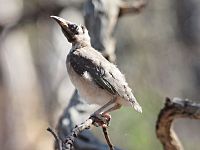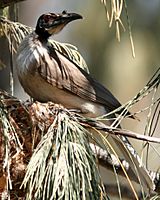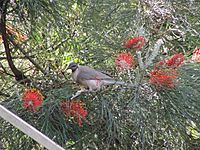Noisy friarbird facts for kids
Quick facts for kids Noisy friarbird |
|
|---|---|
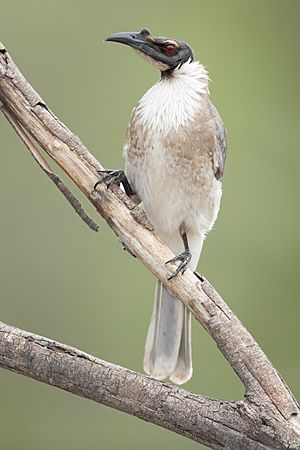 |
|
| Conservation status | |
| Scientific classification | |
| Genus: |
Philemon
|
| Species: |
corniculatus
|
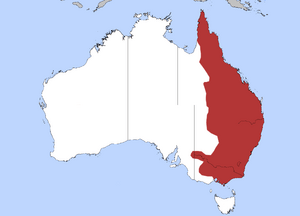 |
|
| Distribution of the noisy friarbird in Australia | |
The noisy friarbird (Philemon corniculatus) is a type of passerine bird. It belongs to the honeyeater family, called Meliphagidae. These birds live in southern New Guinea and eastern Australia. They are one of several birds known as friarbirds. Their heads are mostly bare, meaning they have no feathers. This bird is brownish-grey. It has a clear bump on its bare, black-skinned head. Noisy friarbirds eat insects and sweet nectar from flowers.
Contents
About the Noisy Friarbird's Name
The noisy friarbird was first described by a bird expert named John Latham in 1790. The first part of its scientific name, Philemon, comes from an old Greek word. It means 'affectionate' or 'kissing'. The second part, corniculatus, comes from a Latin word. This word means 'having a little horn'. This refers to the bump on its head.
Sometimes, people call this bird a leatherhead. The local Eora and Darug people of the Sydney area called it Wirgan.
Family Tree of the Noisy Friarbird
Scientists study DNA to understand how animals are related. DNA analysis shows that the noisy friarbird's closest relative is the silver-crowned friarbird. Both are in the Philemon group. Honeyeaters are also related to other bird families. These include the pardalotes, Australian warblers, and fairy-wrens.
What Does the Noisy Friarbird Look Like?
The noisy friarbird is a large honeyeater. It measures about 31 to 36 centimetres (12 to 14 inches) long. Its upper body is a dull brownish-grey. Its underside is a lighter brown-grey. Its black head has no feathers. It only has small tufts of feathers under its chin and above its eyes. This is why it got its name.
You can easily spot it by the round bump above its black beak. This bump is clear even from far away. It has dark blue-black legs and red eyes. As its name suggests, this bird is quite noisy. One of its calls sounds like someone saying "four o'clock."
Where Do Noisy Friarbirds Live?
The noisy friarbird lives naturally in certain areas. You can find them from Lakes Entrance and the Murray valley in Victoria. They live north through New South Wales and Queensland. Their range goes all the way to Cape York. In New Guinea, they are only found in the southern part called the Trans-Fly. They are very common in these areas.
Noisy Friarbird Behaviour
In southern Australia, these birds migrate. This means they move north for winter. Then they return south in the spring. Noisy friarbirds often gather in large groups. They sometimes join with little friarbirds. When many of them are together, their constant cackling and chattering can fill the forest with sound.
Their calls help them mark their feeding areas. They also tell other birds where good food sources are. This includes food that other birds might want to defend. Noisy friarbirds eat nectar, insects, and fruit. They sometimes eat fruits grown by farmers, like grapes and berries. This can cause problems with people who see them as pests. These birds are very protective of their nests. They are known to swoop down to defend them.
Noisy Friarbird Reproduction
Noisy friarbirds usually breed from July to January. They might have one or two groups of chicks during this time. Their nest is a large, deep cup. It has a rim that curves inwards. They build it from bark and grass. The nest hangs from a horizontal branch, usually 1 to 3 metres (3 to 10 feet) above the ground. It is often well-hidden.
They lay two to four eggs, but sometimes five. The eggs are about 22 by 33 millimetres (0.87 by 1.30 inches). They are buff-coloured to pale-pink. They have darker pink-brown or purplish spots.
Gallery
- Complete Book of Australian Birds. Reader's Digest (Australia). 1997.
See also
 In Spanish: Filemón chillón para niños
In Spanish: Filemón chillón para niños



